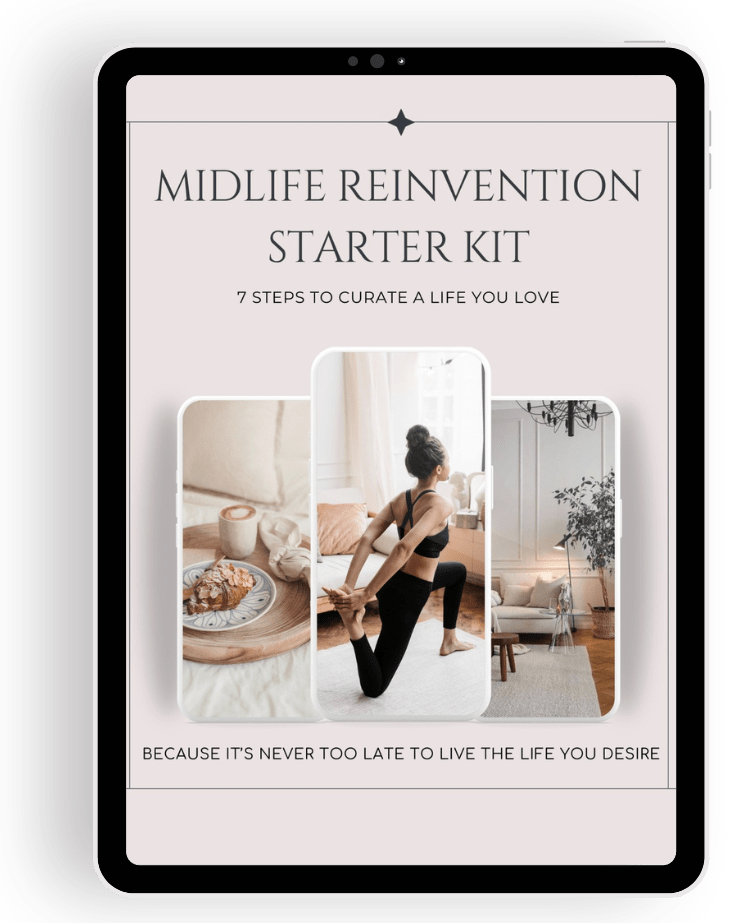Perimenopause and menopause are deeply transformative stages, and the way we nourish our bodies, minds, and spirits during this time can make all the difference. Instead of relying solely on over-the-counter solutions, why not create your own menopause apothecary at home? A personal collection of herbs, natural remedies, and wellness essentials can help balance hormones, ease symptoms, and restore vitality – in a way that feels intentional and empowering.
Here’s everything you need to build a personalised menopause apothecary that supports your unique journey.

1. Building the Foundations of Your Menopause Apothecary
Your apothecary should reflect your needs – whether you’re experiencing hot flushes, anxiety, joint pain, fatigue, or digestive issues. Start by setting up a dedicated space in your home, such as a kitchen shelf, a beautiful wooden box, or a cabinet filled with healing herbs, teas, tinctures, and oils.
Essential Tools for Your Apothecary
- Glass Jars & Tins – To store dried herbs and homemade remedies.
- Dark Glass Bottles – For herbal tinctures and oils.
- A Good Tea Strainer or Infuser – For brewing herbal teas.
- A Mortar & Pestle – To grind seeds and herbs.
- Measuring Spoons & Droppers – To create the perfect doses.
Once you have your tools, it’s time to curate your natural remedies.
2. Essential Herbs for Perimenopause & Menopause
Herbs are nature’s medicine, and they can be incredibly effective in balancing hormones, improving energy levels, and easing menopausal symptoms. Here are some of the best herbs to include in your menopause apothecary:
🌿 Sage: Cooling Relief for Hot Flushes
Sage isn’t just a kitchen herb—it’s a powerful ally in menopause. Traditionally used for its cooling properties, sage has been shown to help reduce hot flashes, night sweats, and mood swings. One study found that fresh sage supplements significantly reduced the intensity of hot flushes within a month.
How to use:
- Brew as a tea by steeping fresh or dried sage leaves in hot water.
- Use a sage tincture or supplement for concentrated benefits.
- Add fresh sage to your meals to enhance flavour and support hormonal balance.
🌿 Black Cohosh: The Classic Menopause Herb
Black cohosh is one of the most well-known menopause herbs, often used to help with hot flashes, sweating, anxiety, and insomnia. Studies show mixed results, but many women swear by it for symptom relief.
How to use:
- Take in capsule or tincture form.
- Combine with other herbs like red clover for enhanced effects.
🌿 Red Clover: Natural Oestrogen Support
Red clover contains phytoestrogens, plant compounds that mimic oestrogen in the body. This can help ease hot flashes, vaginal dryness, and mood swings.
How to use:
- Drink as a tea or take as a supplement.
- Add to herbal blends for a gentle oestrogen-boosting effect.
⚠️ If you have a history of hormone-positive breast cancer, consult your healthcare practitioner before using red clover.
🌿 Kava: The Anxiety & Sleep Soother
Kava has been used in the Pacific Islands for centuries to promote relaxation and ease anxiety. Studies suggest it can help menopausal women with mood swings, irritability, and sleep disturbances.
⚠️ Be mindful—kava has been linked to liver toxicity, so it’s essential to use it responsibly and check with a healthcare provider if you have liver concerns.
How to use:
- Drink as a tea in the evening to promote relaxation.
- Take in tincture or capsule form for more targeted relief.
🌿 Dong Quai: The “Female Ginseng”
Dong quai is a traditional Chinese medicine staple for women’s health. It’s thought to help with hot flashes, vaginal dryness, and blood circulation. While research is limited, it’s often included in herbal blends for menopause support.
How to use:
- Take in capsule or tincture form.
- Combine with black cohosh or red clover for a more comprehensive approach.
🌿 Ginkgo Biloba: Brain Fog & Memory Booster
If you’ve been struggling with memory lapses or brain fog, ginkgo biloba may help. This herb supports blood flow to the brain and cognitive function, making it a great addition to your menopause apothecary.
How to use:
- Take as a supplement or add ginkgo tea to your routine.
- Combine with adaptogens like ashwagandha for stress support.
🌿 St. John’s Wort: Mood Balancer
St. John’s Wort is widely used for mood support and mild depression, which can be common during perimenopause. Some studies suggest it may also help with vasomotor symptoms like hot flashes.
⚠️ St. John’s Wort interacts with many medications, including antidepressants and birth control pills. Check with a healthcare provider before using it.
How to use:
- Take as a tea or supplement for daily mood support.
Adaptogenic Herbs for Menopause
Adaptogens help the body handle stress and hormonal fluctuations, making them ideal for perimenopause and menopause.
🌿 Holy Basil (Tulsi): The Stress & Energy Booster
Holy basil has anti-inflammatory and stress-reducing properties, making it a great choice for fatigue, anxiety, and overall hormonal balance.
How to use:
- Drink as a tea throughout the day.
- Take in supplement form for a more concentrated effect.
🌿 Rhodiola: Mental Stamina & Mood Support
Rhodiola is another adaptogen that supports stress resilience, mental clarity, and energy levels. It’s particularly useful for women experiencing mental fatigue and low motivation.
How to use:
- Take as a supplement or add to herbal blends.
- Combine with ginkgo for brain health support.
🌿 Ashwagandha: The Ultimate Hormone & Sleep Regulator
Ashwagandha is a powerful adaptogen that reduces stress, supports adrenal health, and improves sleep quality. It may also help regulate mood and support libido.
How to use:
- Take as a supplement or add to warm milk before bed.
- Use a tincture for easy absorption.
Additional Herbs for Hot Flushes
🌿 Licorice Root: Natural Phytoestrogen
Licorice root contains natural phytoestrogens that may help reduce hot flashes and balance hormones.
⚠️ Licorice root can raise blood pressure, so avoid if you have hypertension.
How to use:
- Drink as a tea or take in capsule form.
🌿 Evening Primrose Oil: Hormonal Harmony
Evening primrose oil is rich in gamma-linolenic acid (GLA), a fatty acid that may help reduce hot flashes and skin dryness.
How to use:
- Take as a supplement daily.
Pine Bark (Pycnogenol): The Antioxidant Powerhouse
Pine bark extract is a potent antioxidant that has been shown to help with hot flashes and overall menopause symptoms.
How to use:
- Take as a supplement for daily support.
Chaste Tree (Vitex): Hormone Regulator
Chaste tree, or vitex, is known for supporting progesterone levels, helping to balance hormones and easing mood swings and hot flushes.
How to use:
Use in combination with other hormone-supporting herbs.
Take in capsule or tincture form.

3. How to Build Your Menopause Apothecary at Home
- Start with the Essentials – Choose 3-5 core herbs based on your primary symptoms. For example, if hot flushes are your main concern, try sage, black cohosh, and liquorice root.
- Stock Herbal Teas & Tinctures – Many menopause-supporting herbs can be consumed as teas. Tinctures provide a more potent dose.
- Create a Daily Routine – Consistency is key. Take your chosen herbs daily to allow them time to work.
- Monitor Your Symptoms – Keep a menopause journal to track what’s working for you. (DOWNLOAD ➡️ Your Comprehensive Perimenopause and Menopause Symptoms Tracker)
- Combine with Lifestyle Changes – Herbs work best when paired with a balanced diet, exercise, stress management, and quality sleep.
4. How to Use Your Apothecary Remedies
Now that you have your core herbs, the next step is knowing how to use them effectively.
🫖 Healing Herbal Teas (Infusions & Decoctions)
Best for: Hot flushes, stress, digestion, and hydration.
- Recipe: Brew 1 tsp of dried herb (e.g., sage for hot flushes or chamomile for sleep) in 250ml of hot water for 5–10 minutes.
- Drink 2–3 cups daily for best results.
💧 Herbal Tinctures
Best for: Fast-acting relief, especially for stress and hormone balance.
- Buy pre-made tinctures (like Ashwagandha or Red Clover) or make your own by steeping dried herbs in alcohol for 4–6 weeks.
- Take 10–30 drops in water daily.
🛁 Healing Baths
Best for: Relaxation, joint pain, and skin health.
- Add 1 cup of Epsom salts and a few drops of lavender or chamomile oil to warm bath water.
- Soak for 20 minutes to relax muscles and reduce inflammation.
✨ Aromatherapy & Herbal Oils
Best for: Mood support, sleep, and hormone balance.
- Diffuse lavender, clary sage, or geranium essential oil to promote calmness.
- Create a massage oil using jojoba oil + a few drops of essential oils.
5. Creating Daily Menopause Rituals
A menopause apothecary isn’t just about herbs – it’s about building rituals that nourish you. Here’s how you can incorporate your natural remedies into your daily routine:
- 🌞 Morning: Start your day with a cup of maca root or ginger tea for energy and digestion.
- 🌿 Afternoon: Take a few drops of Ashwagandha tincture to balance stress.
- 🛀 Evening: Unwind with a chamomile or passionflower tea and a warm Epsom salt bath.
- 💆🏽♀️ Nighttime: Use lavender essential oil on your pillow or as a calming body oil.
Journaling Prompt: How do I want my menopause journey to feel? What rituals can I create to bring more ease and balance into my daily life?
6. Final Thoughts: Embracing a Natural & Nourishing Menopause Journey
Creating your own Perimenopause & Menopause Apothecary is about honouring your body’s wisdom and finding natural ways to thrive during this transition. Every herb, tea, and ritual is an act of self-care – an opportunity to nourish, restore, and reconnect with yourself.
💛 Take Action:
- Start with 3-5 core herbs that align with your symptoms.
- Create a daily ritual using teas, tinctures, or essential oils.
- Keep a symptom journal to track what works best for your body.
Your menopause journey is unique – let your apothecary reflect your healing, strength, and empowerment. 🌿✨


Feel free to sign up to my Friday Morning Love Note HERE! This isn’t just a newsletter - it’s your invitation to pause, reflect, and realign with you. Every week, we’ll journey together to uncover the small, meaningful shifts that will help you design a life that feels uniquely and beautifully yours. Each week, I’ll deliver fresh intentions, uplifting tips, and simple shifts to inspire purposeful, creative living.





